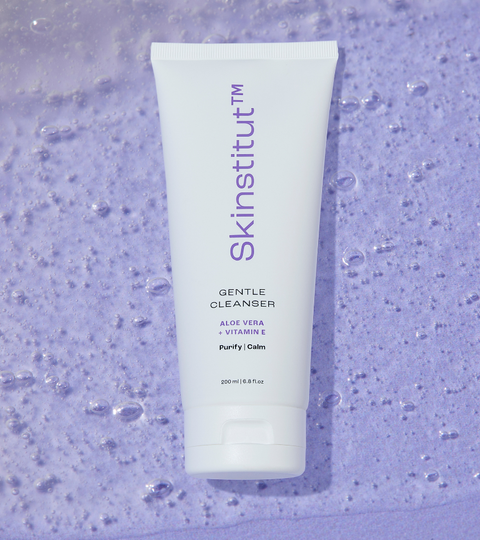By Emily Algar
Cleansing is an essential part of facial skin care and vital to the overall complexion health. The cleansing process removes makeup, pollutants, excess sebum and sunscreen, and keeps pores clear and refined. It also preps our skin for the remainder of our routine, ensuring treatment serums and active ingredients can get in and do their job.
But in a world brimming with skincare options, finding a face wash formula that is perfect for you is not always an easy task. This is especially true if your skin is prone to breakouts, overly dry or easily irritated.
That said, there are ways to navigate the skincare noise. In fact, treat this blog like a compass and it will point you in the right direction for facial cleansers unique to your skin type, as well as the two-step cleansing process, and the best option for specific complexion concerns. Scroll on for more...
What Do Cleansers Actually Do?
An effective face wash will remove makeup, sunscreen, excess oils and pollutants using cleansing agents called surfactants. Depending on the formula and ingredients, it might also gently exfoliate or replenish moisture.
Cleansing also preps the skin so that any product applied afterwards is readily absorbed.
Morning And Night Cleansing: What’s The Difference, And Do I Really Need To Cleanse In The Morning?
The key difference here is that your evening cleanse routine should thoroughly remove everything applied to your face through the day, from skincare and sunscreen to heavier makeup, as well as pollutants and irritants. For this reason, you might want to double cleanse at night (more on this below). The end goal is skin that’s clean, balanced, and prepped.
Morning cleansing is contested because it can seem counterintuitive to wash your ‘clean’ face – and we get it! But as we sleep, sebum, sweat and irritants can accumulate on the skin, from pillows and the surrounding environment – this is especially true if you sleep in air conditioning.
A quick morning cleanse refreshes the skin and removes all the above, as well as any occlusive products used the previous night, so your complexion is better placed to accept your A.M. product line-up.
What Type Of Formula Should I Be Reaching For?
The type of cleanser/ cleansers you should be using depends on a few things: your skin type, specific concerns your complexion has, the makeup you use, and texture preference.
Here’s a quick breakdown to help you decide:
Oil-based cleansers: Anything oil-based is a top choice to break down other oil-based formulas such as sunscreen and foundation. This is why oil cleansers – including balms or straight oils – are often used as a first cleansing step.
Water-based gel cleansers: Gel cleansers are great because they suit most skin types, and when expertly formulated, should leave you feeling super ‘clean’ but not stripped.
‘Active’ cleansers: We love this category! Fun fact: a few Skinstitut cleansers contain active ingredients like Alpha-Hydroxy Acids for simultaneous exfoliation benefits. An active cleanser is a smart choice if you’re looking to improve skin tone or clarity.
A Step-By-Step Guide To Cleansing
Facial cleansing seems simple, but a lot of people rush through the process, and don’t get to experience the full range of benefits. Here are a few golden rules
- Cleanse morning and night, but no more.
- Cleanse for at least 30 seconds.
- At night, you should be double-cleansing.
- Ideally, your first cleanser should be oil-based.
- Once your face is clean, go straight in with skincare.
- If you’re using an exfoliating cleanser, once per day should be plenty.
Formulas To Try
Ready to have your Cinderella face wash moment? Behold! Our line-up of options for every face…
Expert Replenish Squalane Cleansing Oil
This oil-based formula bonds to other oily molecules, so it instantly dissolves sunscreen and waterproof makeup. Because of this, it’s a perfect first cleanser option. It’s also packed with plant oils like Jojoba and Macadamia, plus Squalane and Kakadu Plum to nourish the skin.
Skin type: All skin types, including breakout-prone.
Benefits: Nourishing, softening, and works to remove waterproof makeup. It also rebalances sebum production in oilier skin types.
How to use it: This cleansing oil should be your first cleanse every evening. Bonus: it’s safe for the eye area! If you find your skin is dry, it can also be used in the morning for added nourishment.
A purifying, calming option to remove light makeup and sunscreen without drying or stripping the skin barrier, Gentle Cleanser also tops up moisture levels thanks to the inclusion of Cucumber Seed Oil, Aloe Vera and Vitamin E.
Skin type: All skin types, including breakout-prone and reactive skin.
Benefits: Purifies, rebalances, and rehydrates.
How to use it: Gentle Cleanser can be used morning or night. If you’re using it at night, either use it twice or pair with an oil-based formula.
L-Lactic Cleanser is an AHA cleanser, so it provides gentle exfoliation, too. Lactic Acid is also suitable for dry and more reactive skin types, thanks to its larger molecule size and hydration benefits.
Skin type: All skin types. It’s also a great option for dull, dehydrated skin.
Benefits: Cleanses, gently resurfaces, and rehydrates.
How to use it: Either use L-Lactic Cleanser in the morning or the evening, not both. If you’re using it in the evening, use an oil-based option first.
This deeply purifying formula exfoliates and refines to reveal brighter, smoother skin. It is hydrating and reviving and will leave your complexion feeling invigorated.
Skin type: Normal to combination, oily and breakout-prone skin.
Benefits: Brightens, decongests, and purifies.
How to use it: Use Glycolic Cleanser 12% at night, and precede it with an oil-based formula if you’re wearing heavy makeup.
Don’t forget to check out our skin quiz if you want more information or to map out the rest of your routine.
Want more? Learn about our cosmeceutical serum line-up right here.


